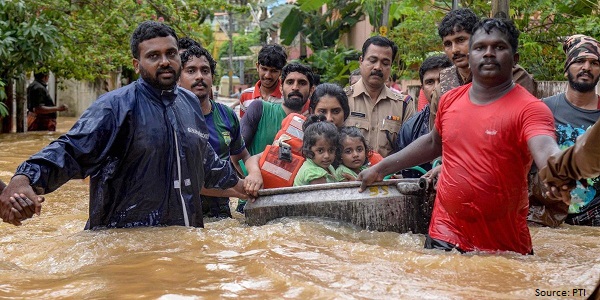
Kerala Floods: Disaster resilience and an uncertain future
24 August 2018
This blog is part of a series on policy decisions, the causes and consquences of the Kerala floods. The second blog can be found here.
The last couple of weeks have not been happy ones. Kerala, my home state, has been pounded by incessant rains the likes of which have not been seen for nearly a century. Kodagu, a beautiful hill district in my home away from home – Karnataka – has also been severely battered. People in both places have reacted with their customary fortitude. Governments have responded fast and alongside people across the country have quickly, with typical Indian generosity, contributed in cash and kind to the needs of the marooned and the rescued. True, there have been some discordant notes, with a few expressing glee at the suffering and hinting at divine retribution, but all of these trouble makers have been quickly put in their place by a groundswell of scorn and disgust from ordinary people.
People have low attention spans, though. So, as soon as the deluge of photos, selfies and videos on social media move to the next big thing, others will forget the event and move on. But for the survivors, this is only the beginning of a long climb back to normalcy. They will return from the relief camps to find their homes devastated, their precious belongings destroyed and their lives disrupted.
We will forget the last two weeks as a bad dream, till the next deluge.
And deluges, there will be. Probably stronger and more dangerous.
Without much scientific basis to support my observations, I have noticed a significant change in Kerala’s weather patterns. As a child, I remember the monsoon arriving with plenty of fanfare on the 1st of June – Edavapaathi, they call it – half way through the Malayalam month of Edavam. In April and May, the weather would grow oppressively hot and humid. There would be occasional thunderstorms, but they would not last more than an evening. The air would be suffused with the perfume of wet soil; it was only much later that I discovered that there is a word for it – petrichor. And then, as June came, it would bring a dark wall of unbroken cloud from the Arabian Sea. With a drum roll of thunder to herald its arrival, the falling rain would be accented by daggers of lightning. We children would run inside, terrified and excited. The yard would fill with water and we would tear up old exercise books to make boats, and rather nastily, in retrospect, float hapless ants in them as passengers. Sometimes conscience would strike and we would splash along our boats, intercepting them before they rushed into ditches, and deposit the bewildered ants back at their nests. We would imagine them recalling to their mates their sailing adventures and then settling down to a hearty meal at home.
After that initial grand entrance, the monsoon would settle into a steady rhythm. It would rain for weeks, never letting up. But the rain would be as gentle as a sigh; there would be no direct sunshine at all. The land would absorb the water like a sponge and then, when saturated, would give up their hoard, softly, into the rivers and backwaters.
Not any longer.
While on an average Kerala still gets more or less the same quantity of rain that it did previously, the number of rainy days seem to have diminished. There are sharp localised storms of unexpected violence, with howling gales uprooting trees and cloudbursts that disappear as quickly as they form. A couple of years back, my ancestral village was hit by one such storm during the pre-monsoon period, leaving hundreds of uprooted trees in its wake and disrupting electric supply and telephone connectivity for days on end. They say that severe storms are going to be the norm due to climate change, but whatever the science behind such predictions might be, there seems to be a discernible pattern in that direction.
Blame has been placed on uncontrolled urbanisation and the rapid increase in construction in sensitive hilly and coastal areas, for the magnitude of the current disaster. There is no denying that people have contributed to their vulnerability by such construction, but this is not a problem that will go away by stating it. Public policies on habitation and disaster resilience have to be crafted, or if they exist, have to be implemented strictly. That in turn carries political implications; nobody wants to be the first in line to advocate for a tough stand to be taken on stopping construction in no-go zones. And furthermore, there are other questions as well; what are the best and least impactful ways to provide housing for all? Who pays for the implementation of climate change mitigation policies, which may range from removing or retro-fitting constructions to protect them, to crafting a transportation policy that reduces the footprint of roads and bridges, which disrupt natural water flow channels?
My blogs over the next few weeks will attempt to look at these issues from the perspective of governance and public finance. I hope to go beyond discussing the immediacies of handling relief measures in the aftermath of a natural disaster, to looking at what may be done to mitigate future damage.
One thing seems to be clear, though. Disasters of the nature of what Kerala and Kodagu are experiencing now, are not going to go away. We have to be prepared for worse.





